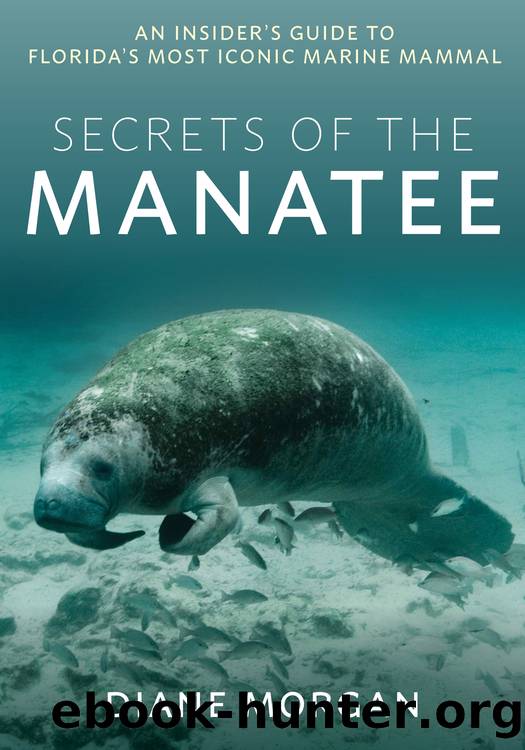Secrets of the Manatee by Diane Morgan

Author:Diane Morgan
Language: eng
Format: epub, pdf
Publisher: Pineapple Press
Published: 2022-11-18T00:00:00+00:00
How Manatees Interact and Behave (Generally Quite Well)
Some animals are nocturnal, like opossums, sneaking around at night. Others are diurnal, like squirrels, running around in daylight. Still others are crepuscular, like deer, preferring the muted light of dawn and dusk. And then there are manatees. They do whatever the heck they want, whenever they like. Time (and time of day) apparently means nothing to them. These quixotic animals can be observed carrying out their regular activities at any time of the day or night. This is especially true during the warmest seasons of the year. In the winter, they tend to gather in the late afternoon to feed and perhaps gossip. They also tend to rest more in the cold weather.
Manatees break up their day into four delightful parts: resting (20â25 percent of their time), eating (20â25 percent), playing (10â15 percent), and traveling (30â45 percent). These numbers are very rough and change by temperature, season, and other factors. One thing is certain: the percentage of time they spend fighting and being disagreeable is 0.
Some scientists have chalked up this lack of scheduling to the fact that manatee brains appear to lack a pineal gland, which regulates this sort of behavior by producing and regulating certain hormones, including melatonin. (They are in good company in this regard with some other marine mammals, hagfish, and mole-rats.) Nearly every other vertebrate has a pineal gland. Walruses and polar bears have really big pineal glands.
At any rate, manatees decided to skip the pineal gland and do not seem to have suffered as a result. The French philosopher René Descartes thought that the pineal gland was âthe seat of the soul,â thus implying that manatees are soulless. However, it is patently obvious that manatees have a great deal more soul than Descartes, who got away with torturing animals by claiming they could not feel pain.
Manatees are classed as âsemi-social,â and although they seem to get along well with each other and even make special friends, they do not, as a rule, form permanent social-familial bonds like dolphins and in general are considered to have a less complex social life. However, it turns out that the more we know about manatees, the more social they seem. And the more intelligent.
Although manatees often communicate by touch, they also vocalize. Dr. Beth Brady has identified five different call types among sea cows. Source: Rathbun Galen, USFWS ROYALTY FREE (PIXNIO-29366-4015x2700)
Download
This site does not store any files on its server. We only index and link to content provided by other sites. Please contact the content providers to delete copyright contents if any and email us, we'll remove relevant links or contents immediately.
The Lonely City by Olivia Laing(4708)
Animal Frequency by Melissa Alvarez(4365)
All Creatures Great and Small by James Herriot(4190)
Walking by Henry David Thoreau(3858)
Exit West by Mohsin Hamid(3743)
Origin Story: A Big History of Everything by David Christian(3590)
COSMOS by Carl Sagan(3514)
How to Read Water: Clues and Patterns from Puddles to the Sea (Natural Navigation) by Tristan Gooley(3372)
Hedgerow by John Wright(3239)
How to Read Nature by Tristan Gooley(3213)
The Inner Life of Animals by Peter Wohlleben(3199)
How to Do Nothing by Jenny Odell(3199)
Project Animal Farm: An Accidental Journey into the Secret World of Farming and the Truth About Our Food by Sonia Faruqi(3140)
Origin Story by David Christian(3117)
Water by Ian Miller(3088)
A Forest Journey by John Perlin(3008)
The Plant Messiah by Carlos Magdalena(2839)
A Wilder Time by William E. Glassley(2789)
Forests: A Very Short Introduction by Jaboury Ghazoul(2764)
